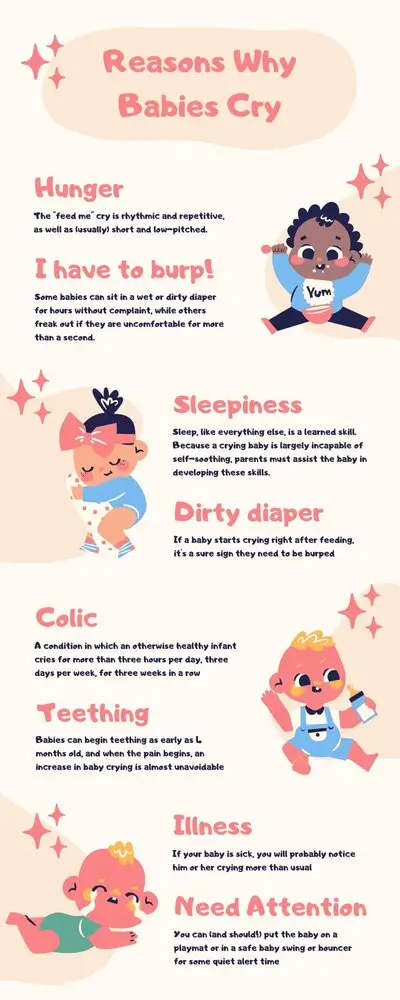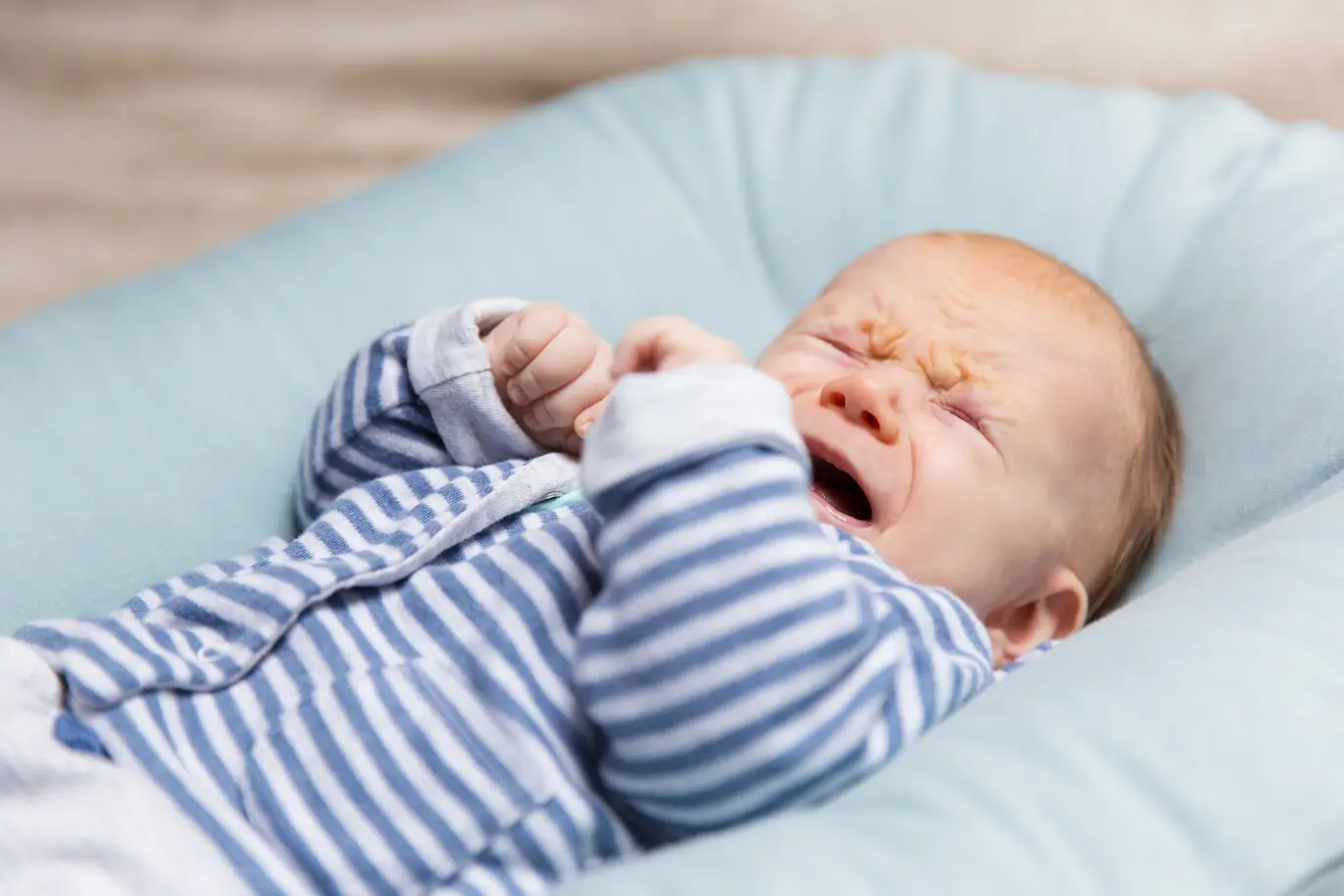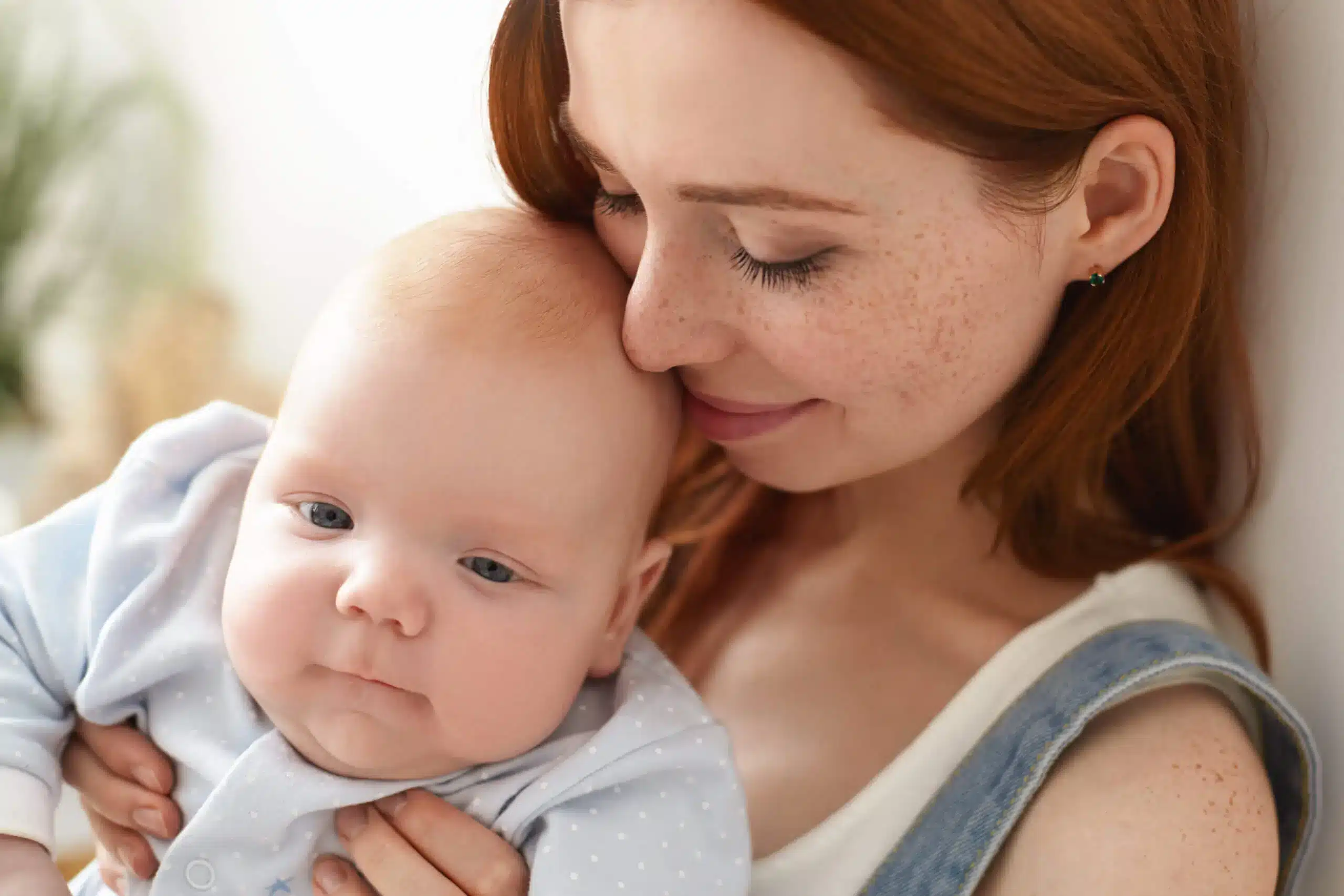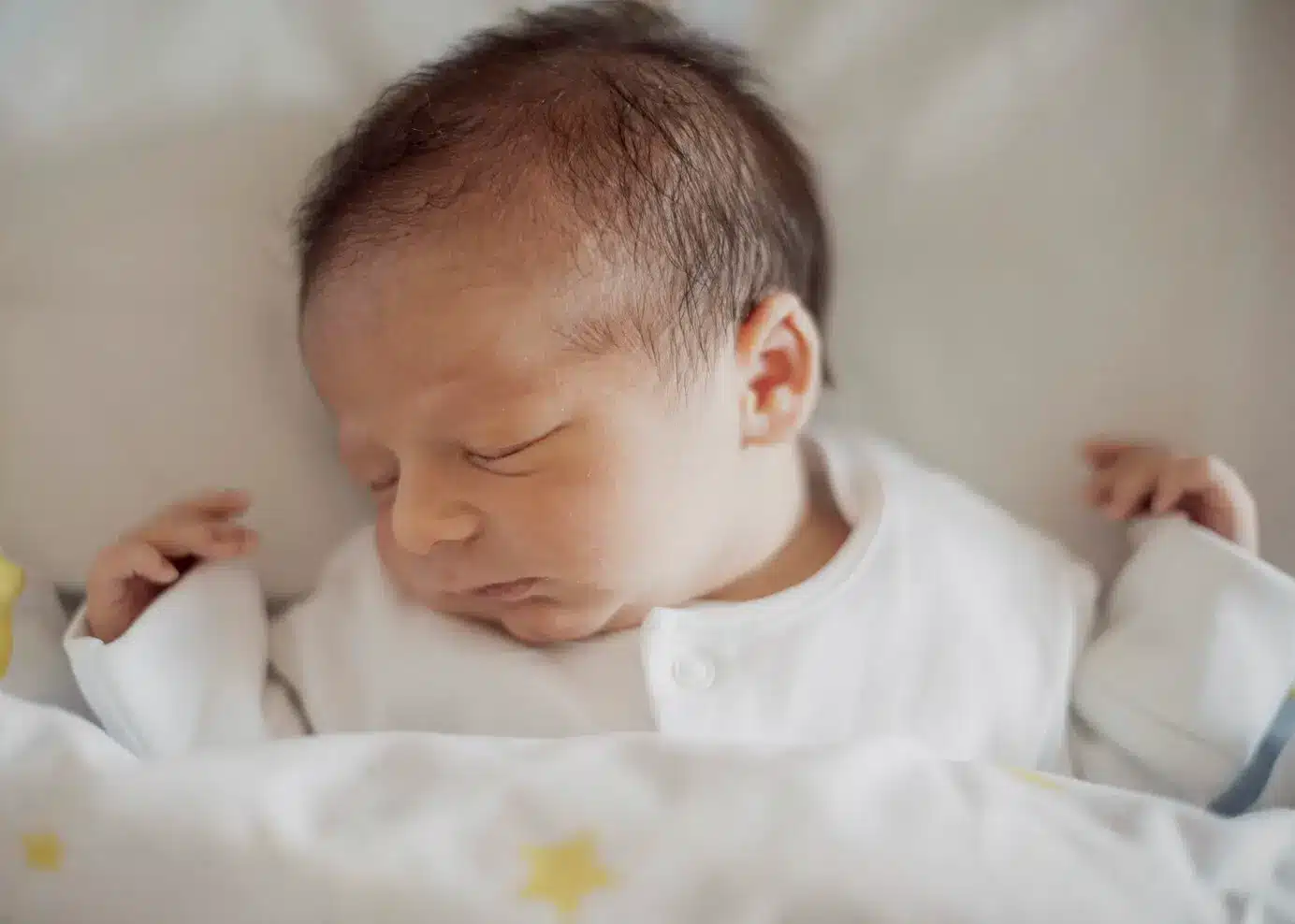Baby cries in sleep can sound alarming the first time it happens. Most episodes are short, normal, and linked to light sleep or a quick shift between stages. Simple checks and steady routines often ease the pattern. Calm steps work better than big changes, and tracking helps spot trends over time.
How baby cries in sleep changes with age
Crying during sleep changes with growth. Sleep cycles lengthen, digestion improves, and daytime routines settle in. Short cries often match light stages or partial arousals. A calm, repeatable response helps the whole household. When a baby cries in sleep, steady patterns matter more than single nights.
crying in sleep newborn: normal patterns vs red flags
In the first weeks, sleep is light and noisy. Grunts, twitches, and brief cries are common as digestion and sleep cycles mature. Short cries may happen even without full waking. Concern rises with repeated high-pitched cries, fever, poor feeding, bluish lips, or labored breathing, those patterns need medical attention. For everyday cases, gentle containment and a calm room help reset. Many families notice that baby cries in sleep decrease as days and nights become more distinct. The phrase crying in sleep newborn often describes these brief, harmless moments.
2 month old crying in sleep: growth spurts and gas
Around two months, feeds shift and digestion keeps developing. Gas can trigger squirming and baby whining in sleep. A slow burp after feeds and a brief pause before intervening often reduces disruption. If comfort comes quickly, observation may be enough. Short wake windows before bed help prevent overtired crying. It is common to hear an infant cry while sleeping for a few seconds, then return to quiet. Many logs will show 2 month old crying in sleep clustered after evening feeds.
5 month old crying in sleep: regression and routines
A well-known regression may appear near this age. More wake-ups, more fussing, and shorter naps can cluster for a few weeks. Consistent routines, a predictable nap schedule, and a calm pre-sleep ritual support resettling. Many families see that the baby crying in sleep peaks during this window, then eases. Gentle coaching, steady wake windows, and balanced daytime calories help smooth the patch. This is also a time when baby cries in sleep can pair with rolling practice at night, a classic 5 month old crying in sleep pattern.
6 month old crying in sleep: teething and solids
Teething gums may throb after bedtime. New solids can add digestive surprises. A cool teether before bed and careful attention to evening feeds reduce night grumbles. Short wake windows lower overtiredness. For some, a baby crying during sleep lines up with new motor skills and a busier brain. Consistency wins here. The pattern where a baby cries in sleep after a late nap often fades once the schedule evens out. Many notes tagged 6 month old crying in sleep also mention teething days.
8 month baby crying in sleep but not awake: separation anxiety & partial arousals
Partial arousals become common around this stage. Eyes may stay closed while a cry rises, then stops. The sleeper may not be fully awake. Short pauses often allow self-settling without extra stimulation. Predictable bedtime routines and steady nap timing limit these events. A brief check can confirm comfort without turning it into a full wake-up. Many reports of babies randomly crying in sleep fall into this group. A frequent description is an 8 month baby crying in sleep but not awake, which often improves with consistent daytime rhythms.
Common reasons for crying in sleep
Short episodes usually match light sleep or simple discomfort. Longer crying, repeated patterns, or strong pain signals call for deeper checks. In many families, baby cries in sleep most during the first hour of night or early morning.

infant cry while sleeping: sleep cycles, startle reflex, REM
Light sleep and active REM increase motion and noise. The startle reflex can trigger a quick cry. Swaddling in early weeks and steady white noise reduce sudden jolts. Over time, the nervous system matures and these moments fade. During these stages, baby cries in sleep may sound brief and breathy, then stop without help. Phrases like crying in sleep baby and babies crying in sleep usually point to these normal shifts.
Hunger, gas, reflux, and newborn whining in sleep
Small stomachs empty quickly. Gas pockets can sting and cause newborn whining in sleep. Gentle burping and a short upright hold after feeds calm many cases. If reflux signs appear or growth falters, medical guidance helps. A common pattern is baby cry in sleep soon after a feed, then quick relief after a burp. Logging time, feed volume, and position after feeds can show useful patterns. On tough nights, notes may read baby cries in sleep several times right after clustered feeds.
baby fussing in sleep vs baby crying during sleep
Fussing sounds soft and uneven. True crying is louder and rhythmic. Fussing often stops on its own in the first half of the night. If baby crying during sleep escalates, a diaper check, quick reposition, or brief pat may be enough. Avoid bright lights and long chats to prevent full waking. Many cases where the baby cry in sleep is unclear turn out to be simple fussing.
Teething, illness, and discomfort
Sore gums, ear discomfort, or a wet/dirty diaper causing night crying are familiar triggers. A clean diaper, comfortable room temperature, and a cool teether before bed help. A stuffy nose can also raise night noise; saline and pediatric guidance can support breathing. With teething, baby cries in sleep may cluster for a few nights, then settle. If symptoms persist, the question why my baby is crying in his sleep often points to discomfort that needs care.
Nightmares, night terrors, and developmental leaps
Bad dreams can emerge later in infancy and toddlerhood. Night terrors, while uncommon in very young infants, can cause intense crying without full awareness. Prevention focuses on steady schedules and adequate total sleep. Developmental leaps rolling, sitting, crawling can shake up sleep for a short stretch. During leaps, many families note that the baby cried in sleep right after a new skill appeared. Search phrases like why babies cry in their sleep often lead to these transition periods.
What to do: calm, practical steps that work
A steady, minimal approach preserves sleep while offering comfort. Think checks first, then small soothing moves. When a baby cries in sleep, the steps below avoid over-stimulation.
Quick checks (diaper, temperature, feeding, burping)
Fresh diaper if damp or soiled. Room in a comfortable range; avoid overheating or drafts. If a feed is due, offer it and add a gentle burp. Reposition for comfort with a light pat or shush. If eyes are closed and the cry is brief, pause; many short episodes of baby cries in sleep stop without help. Questions like why does my baby cry in her sleep often resolve with these basics.
Pace the pause
A short wait often lets the sleeper resettle. Partial arousals end fast, especially during lighter stages when a baby crying during sleep lasts only seconds.
Hunger or habit?
If crying appears near a usual feed, hunger may be the driver. At random times, check gas, temperature, or a wet/dirty diaper causing night crying before offering a full feed.
Gas relief plan
Burp after evening feeds and try a brief upright hold. Gas pockets are common when an infant cries while sleeping following a recent bottle or breastfeed. Gentle tummy circles can help without fully waking the sleeper.
Diaper and skin care
Quick changes prevent irritation that can turn baby whining in sleep into a full wake. A thin barrier cream at bedtime often reduces repeats where the baby cries in sleep in the first sleep cycle.
Room setup
Keep the room dark and quiet. White noise masks sudden sounds that can cause a brief baby to cry out in sleep moment. Maintain a comfortable temperature; avoid heavy layers.
Resettle without pickup
Start with light touch: hand on chest, slow shush, gentle pat. Many crying in sleep newborn episodes end with minimal contact. Lifting too soon can turn a short event into a long wake.
Swaddle or sleep sack
For early weeks, swaddling helps until rolling starts. After that, a snug sleep sack offers contained comfort and reduces transitions where the baby cries in sleep.
Pacifier strategy
If it is already part of bedtime, a quiet re-offer can be enough. Keep lights low and interactions brief to avoid extending baby crying during sleep.
Timed reassurance
If the cry builds, use brief, spaced check-ins (30 seconds, then 60, then 90). Short, predictable contact helps cases where a baby randomly cries in sleep but struggles to resettle.
Day fixes for night gains
Well-timed naps and full daytime calories reduce overnight disruptions. Overtiredness often drives evening spikes in babies cries in sleep. Adjust wake windows gradually over two or three days.
Special case: crying in sleep newborn
Short, breathy cries are common in active sleep. Focus on containment swaddle (until rolling), white noise, and steady room temperature. Persistent, piercing newborn screams in sleep need clinical checks.
Special case: 8 months and partial arousals
Separation awareness peaks around this stage. Many describe an 8 month baby crying in sleep but not awake with eyes closed. A brief pause plus a quiet hallway check often works better than a full pick-up.
When cries become wakes
Open eyes, arching, and louder, rhythmic crying usually signal a true wake. Do the quick checks, then soothe back to sleep. Repeated times where the baby keeps crying in sleep at the same hour often improve with an earlier bedtime and steadier naps.
Comfort add-ons
A cool teether before bed helps on teething days. For congestion, saline and gentle suction before sleep can lower baby cries in sleep linked to stuffiness. Keep the bedtime routine predictable.
Red-flag review
Seek pediatrician advice baby sleep crying for fever, labored breathing, poor feeding, bluish tone, or repeated, piercing newborn screams in sleep. Medical input also helps when growth stalls or reflux signs persist.
Night waking’s vs partial arousals
Short events often mark a normal cycle shift. Longer events with open eyes and strong crying are true wake-ups. A steady plan keeps stimulation low. During many partial arousals, baby cries in sleep once, then drifts back.
baby randomly cries in sleep but resettles
A single short cry may simply mark light sleep. If resettling happens within a minute or two, intervention may be unnecessary. Over-interaction can push the brain toward full waking. During these windows, baby cries in sleep may sound sharp, then fade quickly. Families who ask do babies cry in their sleep usually describe this exact pattern.
baby keeps crying in sleep: patterns that need attention
Repeated episodes at the same time nightly point to overtiredness, hunger timing, or environmental triggers. Slight schedule adjustments often help. Earlier bedtime for a few nights, balanced naps, and fuller daytime calories can make a big difference. If pain signs or illness appear, clinical assessment is appropriate. These patterns also answer why my baby cries in his sleep on many evenings.
newborn screams in sleep: how to respond
High-pitched, sustained crying in a very young infant deserves immediate checks. Think diaper, temperature, gas relief, and feeding. Persistent screaming suggests a need for medical evaluation, even if sleep appears to be the setting. In logs, this may be labeled crying in sleep baby with notes about arching or stiffness.
Routines that reduce babies crying in sleep
A steady rhythm supports longer stretches and easier resettling. Small habits add up. Over a week or two, many homes see fewer episodes where a baby cries in sleep during the first sleep cycle.
Predictable bedtime, white noise, and safe swaddling
A consistent wind-down supports smoother transitions. White noise masks household sounds; swaddling early on (until rolling) reduces startles. For sound tools, see white noise guidance on Smart Sleep Coach. Natural internal links on smartsleepcoach.com cover these steps and explain why baby crying in sleep often clusters in the early night.
Nap timing and daytime feeds
Balanced daytime sleep prevents overtiredness by night. Age-appropriate wake windows matter. Spacing feeds that match daily needs reduces midnight hunger. Many families see improvements within a week after aligning naps and feed volumes. Internal guidance on sleep regressions by age at Smart Sleep Coach offers schedules that often shorten phases where baby cries in sleep.
Gentle coaching options; links to regressions and nightmares resources
Gentle methods can support longer stretches. Short, consistent check-ins build predictability. For structured help during tough spells, see Smart Sleep Coach resources on sleep regressions and nightmares. These guides explain why baby crying during sleep can spike during leaps and how to smooth it.
Environment and comfort checklist
Small changes can lower the chance that baby cries in sleep will repeat overnight.
- Room darkening to block early dawn light.
- White noise at a steady, safe level.
- Temperature in a comfortable range; avoid over-bundling.
- Sleepwear matched to the season.
- Crib clear of loose items to maintain safe sleep.
- Pacifier if already used; many sleepers resettle faster with it.
- For sensitive skin, a barrier cream at bedtime can reduce wake-ups tied to diaper discomfort.
Tracking patterns: simple logging that actually helps
A short note in a phone app or notebook can reveal the “why” behind baby cries in sleep. Log start time, length, feed timing, diaper changes, nap lengths, bedtime, and anything new (teether, solids, travel). Patterns often appear within a week. If babies cry in their sleep turns into frequent nightly episodes, logs offer clear context for medical guidance. Over time, tracking clarifies whether baby cries in sleep in a given home stems from schedules, feeds, or discomfort.
Myths vs facts
Myth: “All crying means hunger.”
Fact: Some cries mark light sleep or gas. A brief pause helps tell the difference the baby cries in sleep.
Myth: “Any cry equals a wake-up.”
Fact: Many short events end without full waking, especially when baby fussing in sleep is the main sound.
Myth: “More stimulation fixes it.”
Fact: Quiet, minimal steps preserve sleep. Too much activity can prolong the cycle when the baby cries in sleep.

When to call the pediatrician
Clear rules reduce second-guessing. Seek medical care for concerning signs, including:
- High fever or repeated vomiting.
- Labored or noisy breathing, blue or gray skin tone.
- Poor feeding, fewer wet diapers, or lethargy.
- Persistent, piercing newborn screams in sleep that do not ease with routine steps.
- Ongoing reflux symptoms, slow growth, or blood in stool.
- A pattern where a baby keeps crying in sleep many nights in a row without clear improvement.
Primary care teams can assess reflux, ear infections, feeding concerns, and sleep-related breathing issues. When reaching out, share a brief log. This helps clarify whether babies cry in their sleep in a specific case points to medical causes, schedule tweaks, or both.
FAQs
Is it normal when a baby cries in sleep with eyes closed?
Ans: Brief arousals are common, do babies cry in their sleep during light stages and often settle without help.
crying in sleep newborn — what’s typical vs a red flag?
Ans: Yes, do baby cries in sleep in short bursts; persistent, high-pitched newborn screams in sleep with fever or breathing trouble needs care.
Why does my baby cry in her sleep after feeds?
Ans: Gas, reflux, or a wet/dirty diaper causing night crying can trigger an infant cry while sleeping soon after feeding; burp, hold upright, and change if needed.
What does a baby crying out in sleep for a few seconds mean?
Ans: A quick baby cries out in sleep often marks a stage shift; wait 30–60 seconds to see if resettling happens.
What’s the difference between a baby fussing in sleep and a baby crying during sleep?
Ans: Fussing is soft and brief; baby crying during sleep is louder and rhythmic, and may need checks for hunger, gas, or discomfort.
2 month old crying in sleep vs 5 month old crying in sleep — what changes?
Ans: At 2 months, digestion and gas are common drivers; by 5 months, a regression and new skills can make baby cries in sleep more frequent.
Baby randomly cries in sleep every night — what to adjust?
Ans: If the baby keeps crying in sleep, review nap timing, earlier bedtime, and daytime calories; stabilize the environment and track patterns.
When to seek pediatrician advice: baby sleep crying?
Ans: Any ongoing episodes of baby cries in sleep with fever, breathing issues, poor feeding, lethargy, or blood in stool warrant prompt evaluation.




